Exercises (62)
Ricochet
Coordination exercises
Partner work
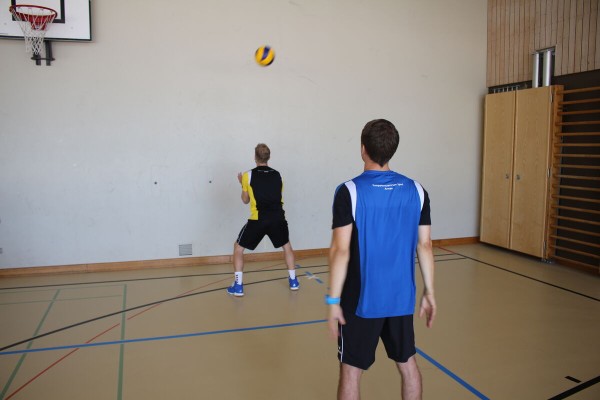
One participant stands one to four metres in front of a wall. The partner throws a ball at the wall behind their back. The participant in front tries to catch the rebound before the pass hits the floor. Change roles after a few (successful) attempts.
► Reactivity
1 wall
1 volleyball
Ricochet
Coordination exercises
Partner work
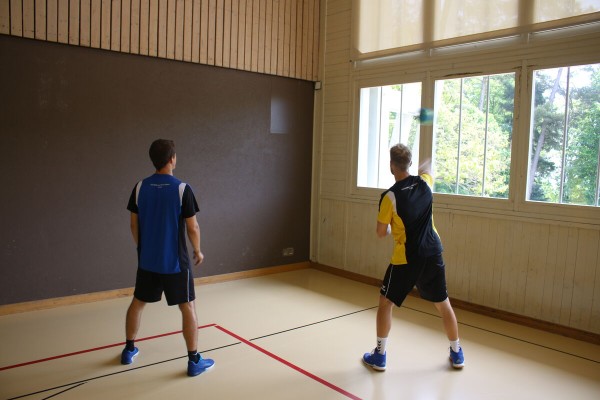
Both participants stand in the corner of a wall and pass a ball to each other over two walls. The partner catches the ball and passes it back.
► Differentiation ability, reaction ability
1 wall corner
1 handball
Ricochet
Coordination exercises
Individual work

Stand on the narrow side of the long bench. Push the medicine ball against the wall with both arms without losing your balance. Catch the ball bouncing off the wall directly (or after touching the floor).
► Balance ability
1 wall
1 long bench
1 medicine ball
Post set-up:
Place the long bench parallel in front of a wall with the narrow side facing upwards at some distance.
Bounce
Coordination exercises
Individual work
Take a running start parallel to the band, jump off over the front foot, touch down on the line with the back foot first, cushion the swing well with your knees and land in a cross-legged stance.
Variant
Jump without a running start with both feet at the same time.
Easier:
Jump onto a lower slackline.
Harder:
Jump onto a higher slackline; jump with a half turn.
1 Slackline
Balance artist
Coordination exercises
Individual work

The participant tries to maintain balance on a balance board (feet parallel or orthogonal to the roller). The exercise can be made more difficult by doing squats or juggling balls at the same time. Advanced users can also stand on the balance board on one leg. For beginners, a friend can provide assistance or you can position yourself in front of a wall that you can support yourself against.
► Balance ability
1 balance board
3 tennis balls
Balance artist
Coordination exercises
Individual work

Stand on the narrow side of the long bench on one leg and perform half and full turns without falling off the bench. After a few attempts, change the standing leg.
► Balance ability
1 Longbank
Balance artist
Coordination exercises
Individual work
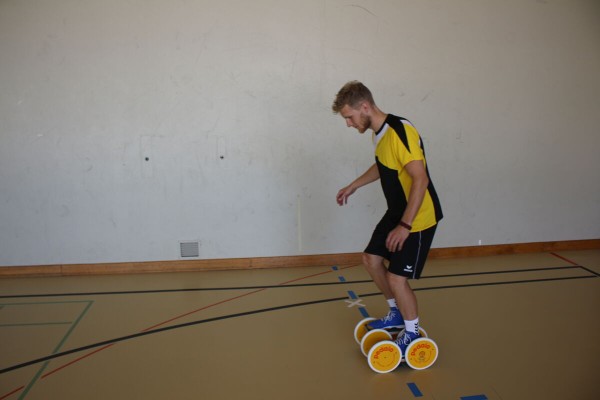
Running a certain distance standing on a running board with wheels.
Difficulty:
Running backwards.
Variant:
Race between group members over a specified distance. On contact with the ground, the respective participant must move back by 2 metres.
► Balance ability
1 footboard with wheels
Balance artist
Coordination exercises
Individual work

Sit on the exercise ball, raise your arms and legs slightly and keep your balance (floating position).
Variant:
Take a kneeling or even standing position on the exercise ball.
►Balance ability
1 exercise ball
Balance artist
Coordination exercises
Individual work

The participant positions themselves in front of the long bench, fixes a point on the ceiling or floor and quickly rotates around their own axis 5-10 times before balancing over the long bench immediately afterwards.
► Orientation skills, balance skills
1 Longbank
ball catcher
Coordination exercises
Individual work
One participant stands on the slackline, the partner on the floor. Now try to pass the ball back and forth as often as possible without the participant on the slackline falling off it.
Heavy:
Both participants stand on the same or different slacklines and try to pass the ball back and forth as often as possible.
1 Slackline
Ball artist
Coordination exercises
Individual work
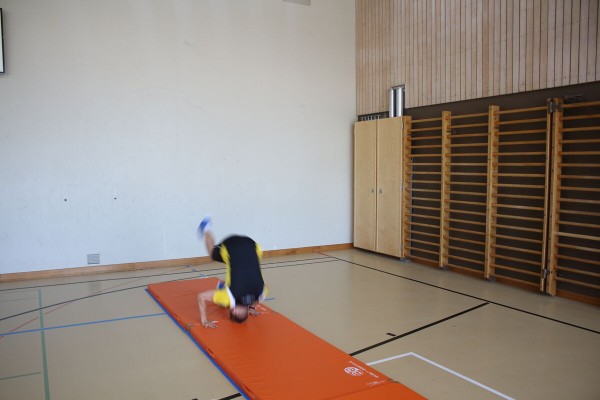
The participant stands at the beginning of the row of mats and throws a soft/foam/volleyball high into the air. The participant then performs a forward roll and tries to catch the ball directly out of the air while standing.
Variant:
Roll backwards; two rolls etc.
►Orientation skills, differentiation skills
4 soft mats (small) ► indoor version
1 soft/foam/volleyball
Turf pitch ► outdoor version
Indoor post set-up:
Using small soft mats to form a row of mats.
Prone position
Coordination exercises
Individual work
Prone position on the slackline. Ideally, the slackline runs diagonally under the body (e.g. right shoulder, left thigh and left shin rest on the line).
Lighten the load:
Hold on to the slackline with one hand.
Lighten the load:
Stretch your arms out to the side; stand up from a prone position.
1 Slackline
Diagonal stand
Coordination exercises
Individual work
Place one foot and the opposite hand on the slackline, stretch out the other limbs (horizontally) and hold the position. The closer the hand and foot are to each other, the less stable the position is; if they are further apart, you need good body tension.
Elevate:
Tap marked points on the ground with your hand; cat walk (move forwards from a diagonal position).
1 Slackline
Distance collector
Coordination exercises
Individual work
The participants form two groups, each of which is assigned to a slackline. Now the participants, one after the other, walk as far as possible along the slackline. The distances travelled by the individual participants are added up. Which group covers a greater distance
Difficulty:
Only metres walked backwards count
1 Slackline
Double passing game
Coordination exercises
Partner work
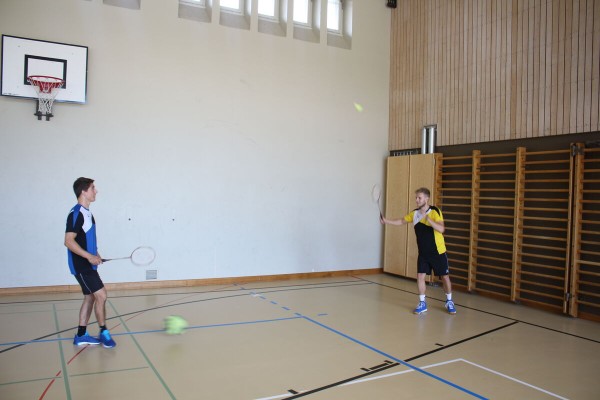
Two participants stand opposite each other at a distance of 3-5 metres and simultaneously pass a football and a shuttle back and forth with badminton rackets.
Variant:
Pass the football and shuttle at the same or opposite pace.
► Differentiation skills, orientation skills, reaction skills
Per group of 2:
2 badminton rackets
1 badminton shuttle
1 football
Dribble artist
Coordination exercises
Individual work
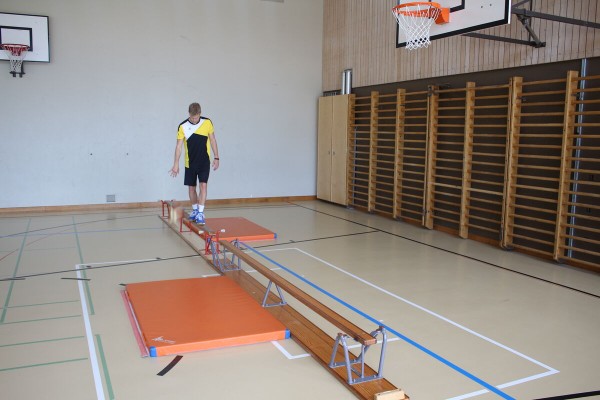
The participant runs across the narrow side of two long benches set up one behind the other and bounces a basketball. In the centre of the two long benches, the side on which the basketball is bounced is changed. Alternatively, or to make the exercise more difficult, two basketballs can be bounced at the same time.
Variant:
Small mats on the floor can make the exercise more difficult, as the side of the bounce must be changed (only possible with one basketball bouncing).
►Balance ability, differentiation ability
2 long benches
2 soft mats (small)
1-2 basketballs
Post set-up:
Place two long benches one behind the other with the narrow side facing up. Place a small soft mat next to each bench (on opposite sides).
Dribble artist
Coordination exercises
Individual work

Bounce two balls on the floor at the same or opposite time. After ten repetitions without interruption, switch to bouncing against the wall.
► Differentiation ability
1 wall
2 basketballs
Dribble artist
Coordination exercises
Individual work
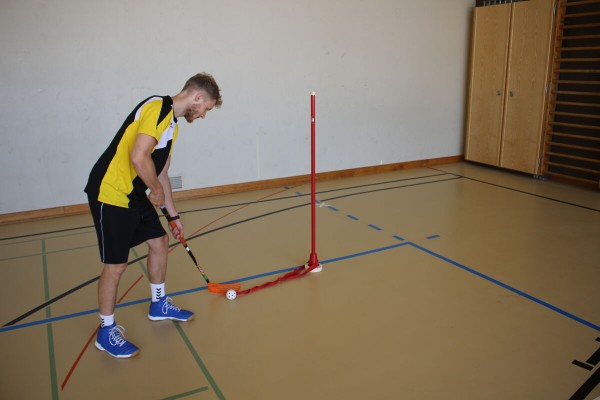
The participant uses the floorball stick to hit the ball clockwise and anti-clockwise around the stake with forehand and backhand strokes.
Variant:
If the ball is only attached with a ribbon (shorter pendulum), the exercise becomes more difficult.
►Rhythmisation skills, reaction skills
1 stake
2 game ribbons
1 floorball stick
1 floorball ball
Post setup:
A floorball ball attached to two linked game ribbons is placed loosely around a stake.
Dribble artist
Coordination exercises
Partner work
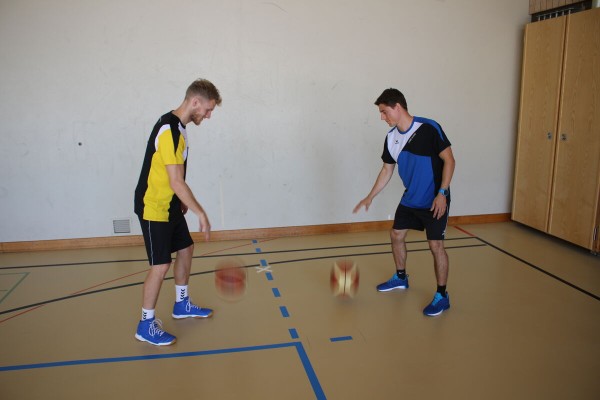
One participant bounces a rhythm with the (basket)ball, the second participant tries to copy the rhythm at the same time.
Variant I:
The imitator bounces twice or half as fast.
Variant II:
Perform the exercise alone with two (basket)balls, bouncing with one hand twice as fast as the other.
► Rhythm skills
2 basketballs
Duel
Coordination exercises
Individual work
Two participants stand on the same slackline at the same time and try to stay up longer than their opponent. Who has 5 points first?
Easing:
Another participant sits in the centre of the slackline.
Heavier:
The participants each hold one end of a skipping rope and try to unbalance the other by pulling; the participants try to unbalance each other with a foam club or a foam ball.
1 Slackline
Dunking
Coordination exercises
Individual work

The participants jump onto the mini trampoline with the basketball in their hands and try to sink the ball into the basket with a basketball shot or even a "dunk".
► Rhythmisation skills, differentiation skills, orientation skills
1 mini-trampoline
1-2 soft mats (large)
4-6 soft mats (small)
1 basketball
Post set-up:
Place the large soft mat(s) under a basketball hoop and set up a mini-trampoline in front of it. For additional safety, place small soft mats around the large soft mat(s).
First steps
Coordination exercises
Individual work
Once you have mastered the basic position, you can try your first steps. It is important to feel the strap with the forefoot before putting the whole foot down. This means you don't have to look at the strap to know where it is. Before you remove the back foot from the strap, you should place it on your toes to shift your centre of gravity to the front foot.
Easier:
Stretch the slackline tightly over a short distance (3-5m); help a partner by holding their hand (always go with the balancing movement and only stabilise when the slackliner is almost falling).
Harder:
Walk backwards; stretch the slackline over a long distance.
1 Slackline
Buttock rocker ► buttbounce
Coordination exercises
Individual work
Fasten the slackline over a long distance (12-15m) at a height of approx. 1m. Sit in an upside-down position so that your eyes and shoulders are aligned with the end point. From this position, rock downwards and upwards, with the momentum coming from the arms. You can touch the ground with your feet, but you should not actively push off, as the energy should come from the slackline.
Lighten the load:
Help a partner by holding their hand; a helper pushes the slackline down slightly while bobbing.
1 Slackline
Basic position
Coordination exercises
Individual work
Before attempting the first steps, you should be able to stand on the slackline on just one leg for 5-10 seconds. This has the advantage that you can balance with the second leg. Both the left and right leg must be trained.
Pay attention to the following points:
- Looking forwards;
- Arms above shoulder height;
- Feet straight on the slackline;
- Knees slightly bent;
- Hips upright.
Easing:
Perform the exercise close to the attachment; stretch the slackline taut over a short distance (3-5m); sit a partner in the middle of the slackline to dampen the initial shaking; help a partner by holding their hand (always go with the balancing movement and only stabilise if the slackliner is about to fall).
Hardening:
Cross your arms (in front of your stomach, behind your back or over your head)
1 Slackline
Half turn
Coordination exercises
Individual work
In the starting position, the front foot is turned inwards and the back foot is straight on the band. Your body weight is on the front foot. Now turn the back foot 180 degrees and simultaneously change your gaze in a quick movement (similar to a pirouette).
Lighten up:
Help a partner by holding their hand (always go with the balancing movement and only stabilise if the slackliner is about to fall).
1 Slackline